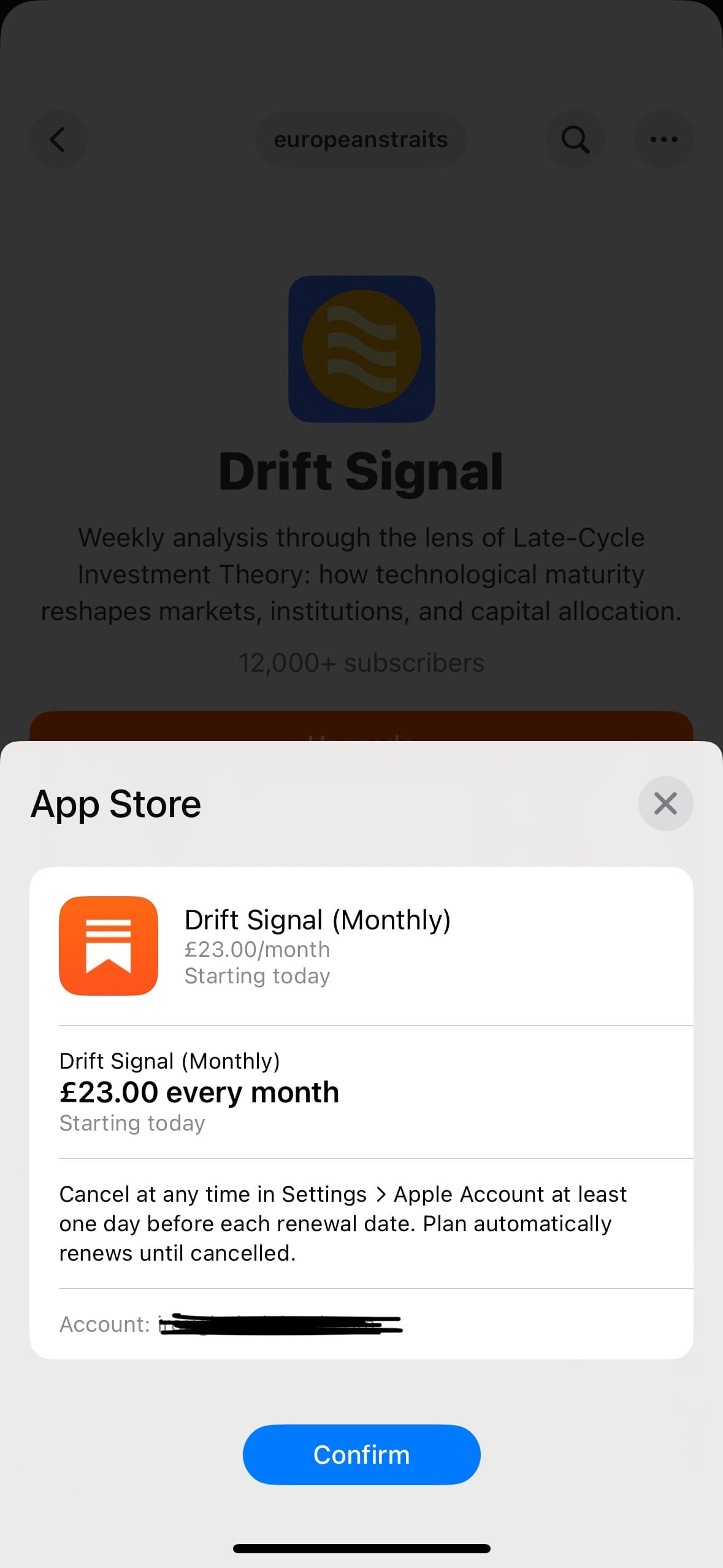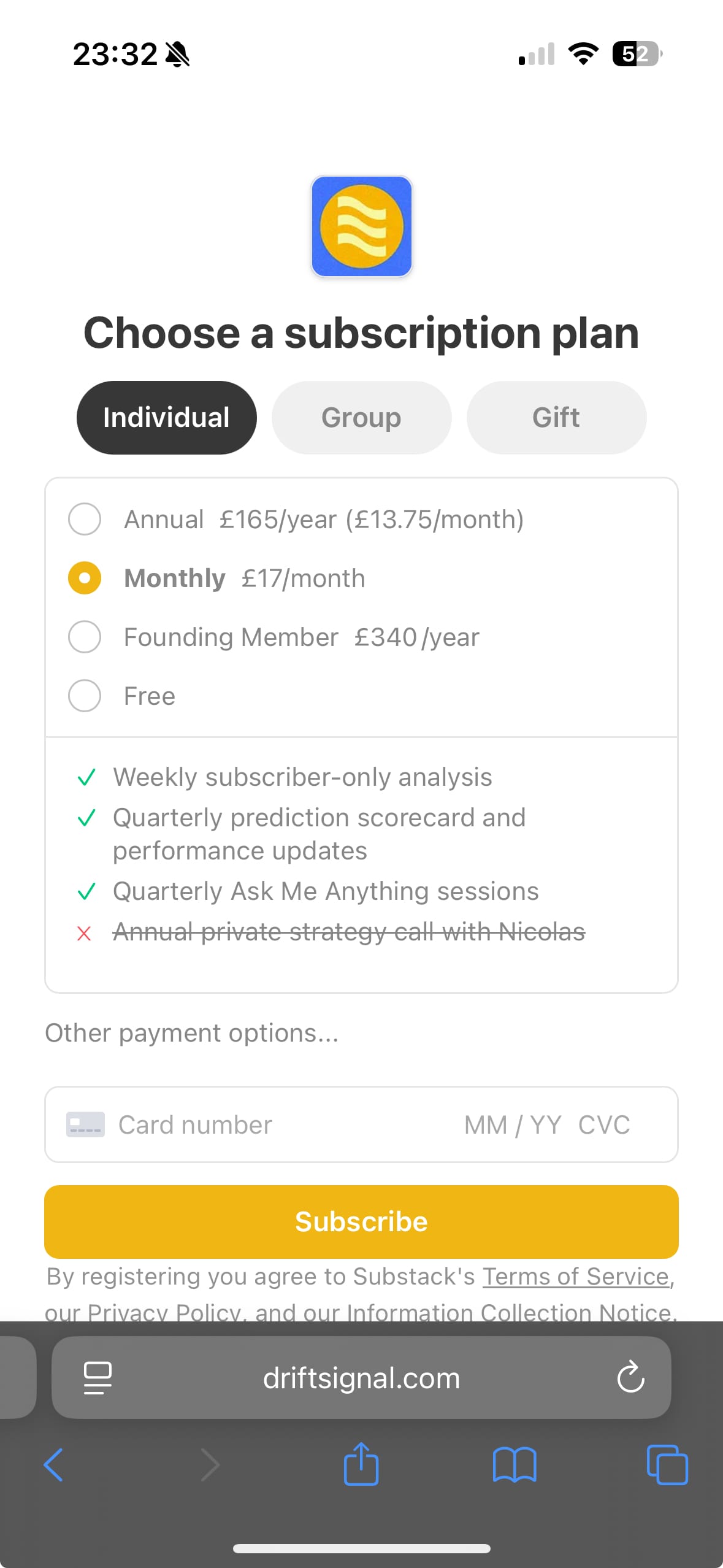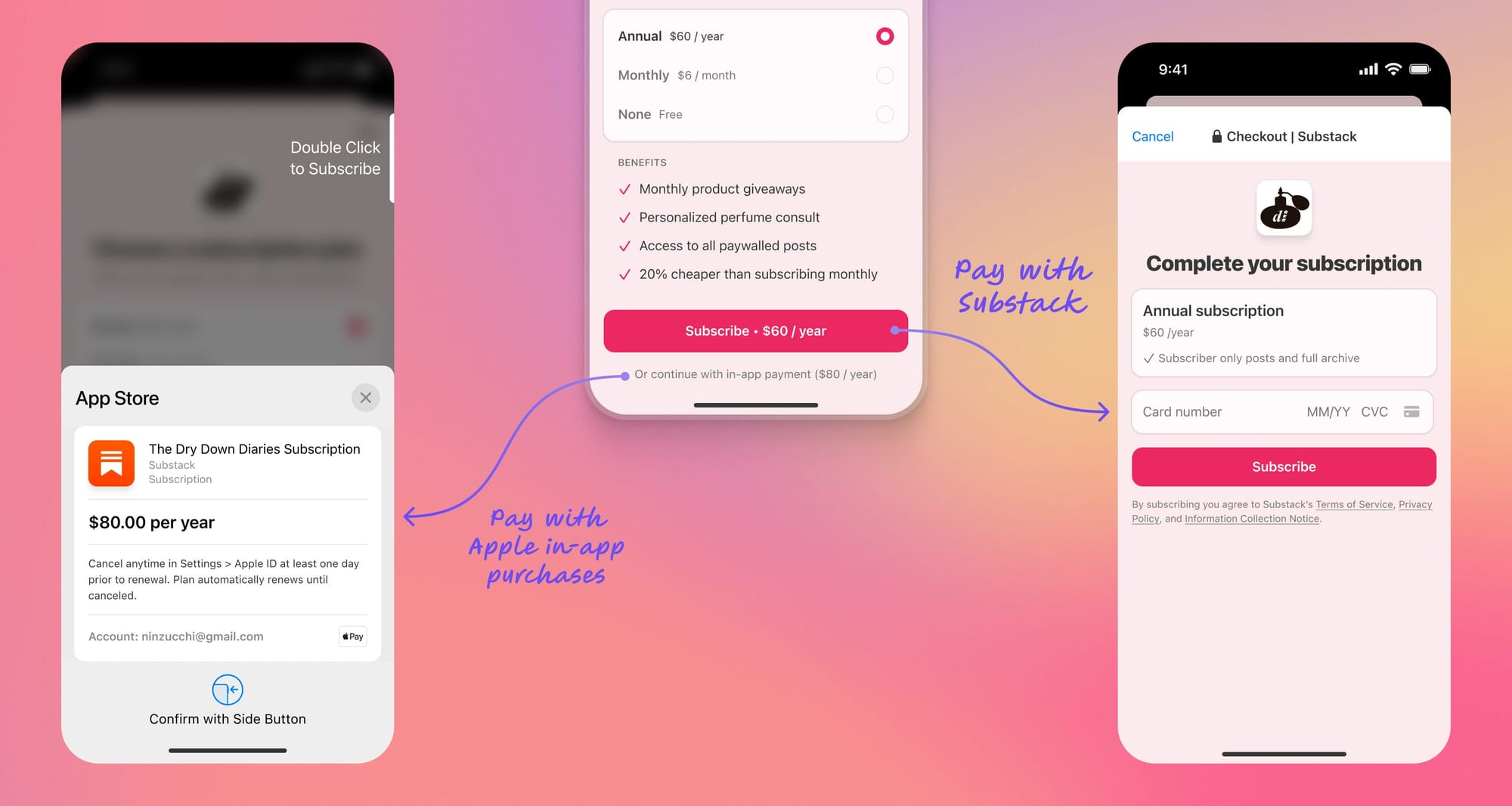
How Substack delivered its users onto Apple
With the forced introduction of Apple in-app payments, the Substack enshittification process is complete for publishers.
(Updated 19 Aug after seeing screenshots of the US subscription flow)
After years of aggressively promoting its mobile app, today Substack added Apple in-app payments (hereafter known as IAP) to it. When readers outside the US (we'll get to this) choose to 'upgrade to paid' on any publication within the iOS app, they will now be directed to Apple's closed system and their subscription will be managed through the App Store. Apple will take its usual 30% cut of the transaction. By default, Substack will pass that cost on to the baffled customer, who will without explanation be shown an inflated subscription price. Otherwise, the publisher can choose to eat that extortion rate out of their own tiny margins. Rather than paying instantly, Apple will wait up to 45 days to disburse a whole month's revenue to Substack, who will then disburse it to the publisher. According to Substack's own comms, a payment made through IAP in January could reach the creator by mid-March. Publishers cannot opt out.


A paid subscription to Nicolas Colin's Drift Signal, which the writer priced at £17/month, costs £23 on the Substack app to account for Apple's 30% take. (The difference is more than 30% because with the higher price, Substack's own 10% cut and Stripe fees also increase.) As a UK customer, I am not given any indication that a lower price is available elsewhere.
But there's worse for publishers than taking cash flow hostage – taking data hostage. In this scenario, the new subscriber's billing relationship will be to Apple, not to the publication. The publisher will not have access to the subscriber's financial information and will not be able to take that customer with them, should they wish to move away from Substack to another CMS. This is the end of subscriber portability. The end of Substack's single argument for moral superiority over other platforms. The end of pretence.
Substack caved in to Apple's kleptocratic rule and sacrificed non-US publishers
Substack had long resisted Apple's siren call. Until now, readers simply could not upgrade to a paid subscription within the app. They had to go to the mobile Web or their laptop. I have some sympathy for Substack having to play by rules they did not write and work with Apple's dominant position among their target demographic in the US and Europe. Apple makes app developers use its own payment system or nothing, and Apple prohibits app developers from letting individual users opt out. The Substack mobile app is the company's primary growth engine and not offering paid subscriptions there is a bad user experience. (My sympathy ends here; Substack chose to aggressively push users to the IOS app and downgrade more open protocols like email or the mobile Web. See my previous essay.) Already a year ago, cofounder Hamish McKenzie was trying to square the circle and confessing to being in tentative talks with the Cupertino giant. A breach was opened this spring when, in a case brought by Epic Games, the maker of Fortnite, a California judge compelled Apple to allow other payment options than its own within iOS apps. Substack CEO Chris Best called the changes "fantastic" and "a big win for independent media."
The legal decision means that for US users, the default payment button in the iOS app circumvents Apple's system, giving users the option to pay Substack directly. The payment flow design makes it unlikely many US subscribers will choose the more expensive IAP. But Apple isn't making that option available outside the US until EU regulation or national courts force it to. For non-American readers, which will be most customers for non-American publications, IAP will be the only option. In a not-unheard-of move for Silicon Valley, Substack has thrown its "international" users under the bus in the name of American growth.

Publishers end up captured by one Big Tech giant... and delivered onto another
Substack's argument is that it's only adding another entry point for new subscribers and therefore growing the pie for everyone (including its and Apple's own generous slices). "These IAP payments are new revenue you wouldn’t have had access to before," Substack's spokesperson told users. It's probable that a frictionless subscription option in a widely used app will indeed lead to new revenue. It's also naive to think it won't cannibalise subscriptions that would have happened elsewhere. Still, I suspect it will net out revenue-positive. Substack has no interest in making product calls that lose its publishers – and itself – money.
Substack has made a decision that prioritises scale over control for its publishers, particularly outside the US. In the name of reaching more potential customers, in-app payments may end up damaging publications in other ways:
- The 30% markup will sour the subscriber's impression of the publication and likely deter some sales. So will Apple's pesky habit of not warning customers before charging their card at renewal.
- Payouts will be very slow, leading to potential cashflow issues.
- The only customer data available to the publisher will be an email address. This won't increase user privacy or experience. Apple will be extracting the value instead.
- The publisher will not own the customer service relationship. If a subscriber does reach out on account management issues, they'll likely leave frustrated. No custom pricing, discount, comp, refund, paused billing... no room whatsoever for a nice commercial gesture. No capturing why a subscriber cancels, nothing you can do to prevent them churning.
- The publisher can expect angry messages when readers realise that unsubscribing from the newsletter within Substack does not cancel the Apple Store payments.
- And the big one: The publisher will increasingly be locked in to Substack, with every IAP subscriber lost if they choose to go elsewhere.
Apple is doing all this, not Substack. But the major theme that comes out of publishers' comments on the company's announcement is one of frustration. Substack made a major decision for their businesses and they have no control over it. They weren't consulted and they cannot opt out. First, Substack corralled them and their readers onto its mobile app. Next, it delivered them into the hands of another tech giant, which extracts more value than it appears to offer. And there's nothing they can do about it. That's the thing with building a business on a closed platform: you may get fattened up, but you are never safe from slaughter.
Hey, you read to the end!
Don’t miss future articles like this one; let me into your inbox.


